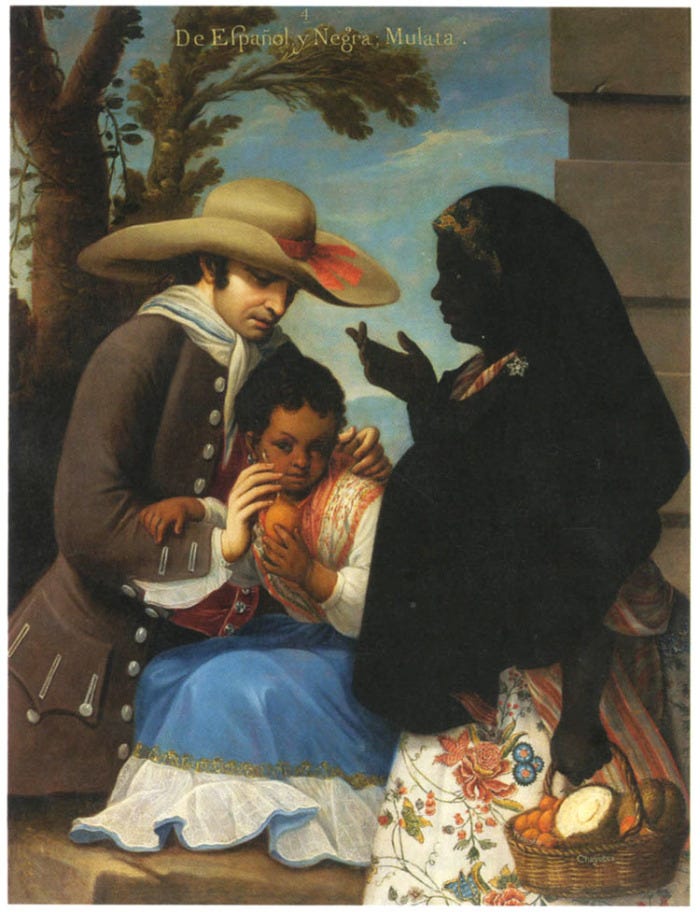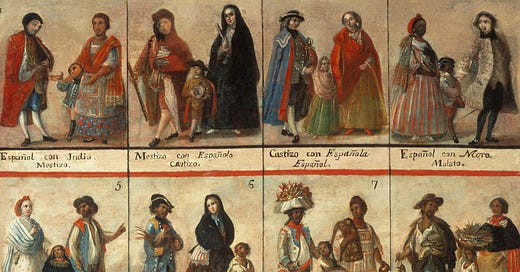Casta Paintings: The Original Identity Politics? (18th C)
Visual Guides to the Intersection of Race and Status in Colonial Mexico
Casta paintings are a form of artwork created in eighteenth-century and early nineteenth-century Mexico and used by elites to create and assign race to people of various ancestries.
Casta paintings were presented most commonly in a series of sixteen individual canvases or a single canvas divided into sixteen compartments.
The series usually depict a man, woman, and child, arranged according to a hierarchies of race and status. The paintings are usually numbered and the racial mixtures identified in inscriptions.

Spanish men are often portrayed as men of leisure or professionals, blacks and mulattos as coachmen, Indians as food vendors, and mestizos as tailors, shoemakers, and tobacconists.
Mulattas and mestizas are often represented as cooks, spinners, and seamstresses.

Casta paintings show increasing whitening over generations with the mixes of Spaniards and Africans. The sequence is the offspring of a Spaniard + Negra, Mulatto; Spaniard with a Mulatta, Morisco; Spaniard with a Morisca, Albino (a racial category, derived from Alba, "white"); Spaniard with an Albina, Torna atrás, or "throw back" black.
In contrast, mixtures with Black people, both by Indians and Spaniards, led to a bewildering number of combinations, with "fanciful terms" to describe them.
Instead of leading to a new racial type or equilibrium, they led to apparent disorder - such as tente en el aire ("floating in mid air") and no te entiendo ("I don't understand you")—and others based on terms used for animals: coyote and lobo (wolf). ~ Casta Paintings
Español: Pintura de castas con todas las 16 combinaciones. (translated below)
1. Español con India, Mestizo
2. Mestizo con Española, Castizo
3. Castizo con Española, Español
4. Español con Mora, Mulato
5. Mulato con Española, Morisca
6. Morisco con Española, Chino
7. Chino con India, Salta atrás
8. Salta atras con Mulata, Lobo
9. Lobo con China, Gíbaro (Jíbaro)
10. Gíbaro con Mulata, Albarazado
11. Albarazado con Negra, Cambujo
12. Cambujo con India, Sambiaga (Zambiaga)
13. Sambiago con Lobo, Calpamulato
14. Calpamulto con Cambuja, Tente en el aire
15. Tente en el aire con Mulata, No te entiendo
16. No te entiendo con India, Torna atrás
English Translation: Casta painting with all 16 combinations (via Google Translate)
1. Spanish with Indian, Mestizo
2. Mixed with Spanish, Castizo
3. Castizo with Spanish, Spanish
4. Spanish with Mora, Mulatto
5. Mulatto with Spanish, Moorish
6. Moorish with Spanish, Chinese
7. Chinese with India, Skip Back
8. Jump back with Mulata, Lobo
9. Wolf with China, Gíbaro (Jíbaro)
10. Gíbaro with Mulata, Albarazado
11. Albarazado with Black, Cambujo
12. Cambujo with India, Sambiaga (Zambiaga)
13. Sambiago with Loba, Calpamulato
14. Calpamulto with Cambuja, Feel in the air
15. Feel in the air with Mulata, I don't understand you
16. I don't understand you with India, go back
Featured Image
Creator: Unknown author
Date: 18th century
Archive: Museo Nacional del Virreinato, Tepotzotlán, Mexico
Image source: Wikipedia





Wow. This perfectly exemplifies Spanish cognitive dissonance assuaging guilt from their record of horrible colonialism and grisly racist atrocities.
“I don’t understand you, go back”. It’s on you and not me!!